3D Model Tree |
  
|
To open the 3D model tree window use the command
Icon |
Ribbon |
|---|---|
|
Get Started > Options > Tool Windows > 3D Model Tree View > Window > Tool Windows > 3D Model Tree
|
Keyboard |
Textual Menu |
<Alt>+<3> |
Customize > Tool Windows > 3D Model Tree |
The window titled 3D Model will appear at the left side of the screen. This tool window reflects the structure of the 3D model as a tree.
The search panel allows to find an element in the 3D model tree by its name or part of the name. Elements, whose names match the required name, will be displayed in the tree after searching.
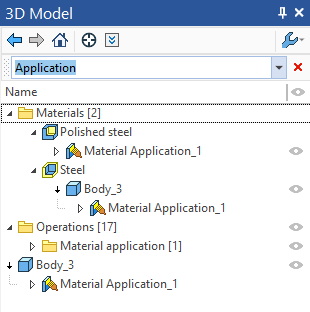
The search panel can be moved or hided.
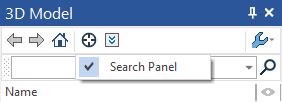
Columns allows to change elements parameters and to receive information. You can change parameters for several elements at once.
For example, if you want to hide several workplanes, it is necessary to select the planes and press ![]() in the Visibility column.
in the Visibility column.
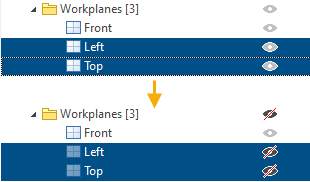
If any parameter can’t be changed, its symbol will not appear in the column.
The drop-down list is used to select columns:
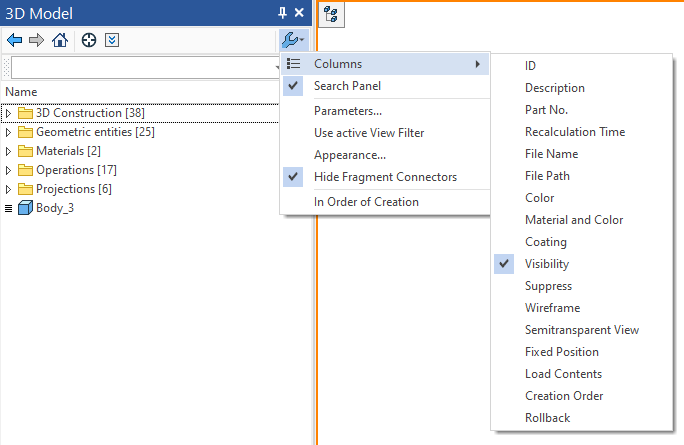
Bodies are put at the root of the model tree. Depending on the Body geometry type (solid or sheet object), the respective icon will be used for it in the model tree.
Each model Body is assigned a unique name, by default composed of the word “Body” and a number, for example, “Body_1”. If necessary, any Body can be assigned an arbitrary individual name in the Body parameters.

The 3D Fragment, Part and 3D Array creation operations can be displayed at the top level of the model structure, along with Bodies.

The Body knots are marked by the glyph ![]() . It allows watching the history of the given body’s creation.
. It allows watching the history of the given body’s creation.
Point the mouse at the glyph ![]() and click
and click ![]() .
.

As the model tree branch with the Body history expands, the glyph changes to ![]() The Body history consists of a sequence of their defining operations, displayed as a list. The list is formed from top down in the order of creating or using operations. To hide the Body history, point to the glyph
The Body history consists of a sequence of their defining operations, displayed as a list. The list is formed from top down in the order of creating or using operations. To hide the Body history, point to the glyph ![]() and click
and click ![]() .
.
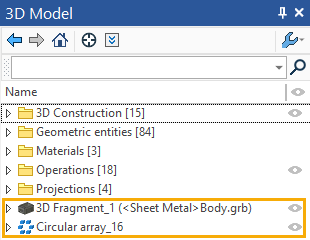
Each model element entered in the Body history has a unique name. By default, the name consists of the name of the element type and a number, for example, “Extrusion_6”. If desired, the element, just like a Body, can be assigned an arbitrary individual name.
Named elements can be further used to perform measurements, search for source elements when creating operations by name (for example, Blend operation). Named elements are available for obtaining information about the dependencies in Information command dialog. Option Delete that removes dependent objects is also available for them. Named elements, when used for subsequent creation of new operations based on them, retain their names. If the named geometric element is located on a visible body, it is marked in the 3D window when it is selected in the model tree.
You can change the geometric element name using the Parameters command in its context menu. Names may be set for vertexes, edges, cycles, faces.

The ![]() glyph before the element means this element is based on other elements. To expand this model tree branch and view the element’s parents, point the mouse to the glyph
glyph before the element means this element is based on other elements. To expand this model tree branch and view the element’s parents, point the mouse to the glyph ![]() and click
and click ![]() . After that, the glyph will change to
. After that, the glyph will change to ![]() . If there is no glyph before the element, this means the element is the last one on this branch of the 3D model tree.
. If there is no glyph before the element, this means the element is the last one on this branch of the 3D model tree.

If the creation history can be built for an operation, then the history will be displayed instead of the parents. In this way, the ![]() glyph is put before the operation name instead of the
glyph is put before the operation name instead of the ![]() glyph. An operation's history is displayed in the same way as a Body’s history.
glyph. An operation's history is displayed in the same way as a Body’s history.
The Boolean operations are displayed in a special way in the history. The type of Boolean (addition, subtraction or intersection) is drawn before the icon of the operation that comes as the second operand of the Boolean. The diagram shows the history of the operation “Boolean_1”: the body “Box_1” is subtracted from the body “Box_2”.

In addition to the list of Bodies, in the root of the model tree there are also special branches of the tree in which all 3D elements created in the current model are enumerated. Auxiliary 3D elements are put on the branch 3D Construction. All operations are on the second branch, Operations. 3D annotation (3D dimensions, 3D leader notes, etc.) are put into the branch 3D Annotations. The Mates branch lists all constraints created in the given model. All elements are sorted into the folders by types: 3D Nodes, Workplanes, 3D Profiles, etc.; within the folders, the elements are sorted alphabetically. The number next to the folder name and the colon means the number of elements of this type contained in the model. By expanding branches of the model tree, you can access any element of the 3D model.
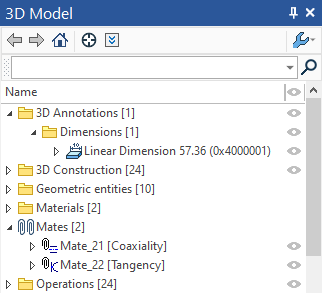
Separate branches-folders can be created for grouping Bodies, 3D fragments and 3D array. To do it, in the context menu for the Body which you want to put into a separate folder, invoke the command Move to Folder > New folder from the context menu. A window for specifying the name of the folder being created will appear on the screen. After specifying the name and pressing [OK], there will be a folder having the specified name in the tree of the 3D model, and the selected Body will be put into this folder.
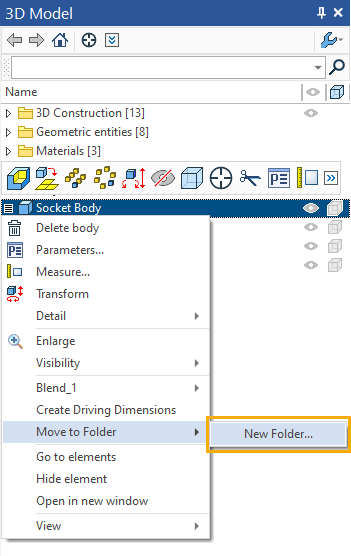

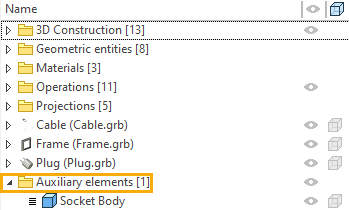
If in the tree of the 3D model at least one Body folder has been already created, in the context menu for each body in the submenu Move to Folder, a list of existing Body folders will be also present. The folder that contains the current body will be marked. For moving Body into one of the already existing folders, it is enough to select the folder in the list.
It is also possible to move Bodies from the root of the model tree to the folder and backwards just by dragging Bodies while pressing ![]() .
.
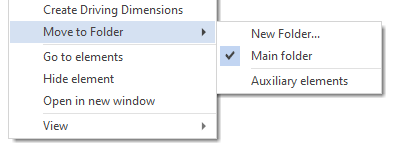
In certain cases, operations can be reordered by moving their labels within the model tree. This effectively changes the model structure and geometry. Press ![]() on the element label and drag it to a new location in the tree. The following diagrams demonstrate the result of reordering an element in the model tree. In the beginning, the operation Shell_1 followed the subtraction operation (Boolean) Then, the Boolean, together with its tool body operand Extrusion_2 (a cylinder), was reordered to be after the shell operation.
on the element label and drag it to a new location in the tree. The following diagrams demonstrate the result of reordering an element in the model tree. In the beginning, the operation Shell_1 followed the subtraction operation (Boolean) Then, the Boolean, together with its tool body operand Extrusion_2 (a cylinder), was reordered to be after the shell operation.
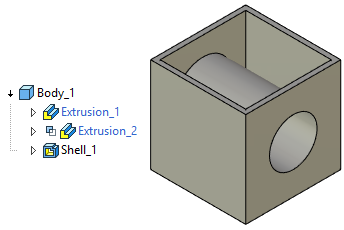
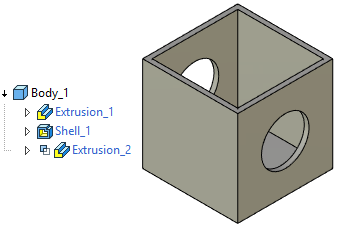
The model tree helps quickly create Boolean operations of all types. If you select a Body and drag it over another Body, the indicator of the Boolean “addition” will appear at next to the pointer. If you additionally press the key <Ctrl> or <Shift>, the type of the Boolean changes to subtraction or intersection, respectively. Instead of Bodies, you can select operations that are last in their histories.
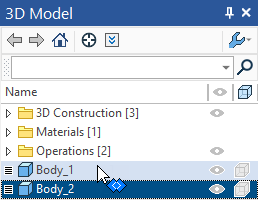
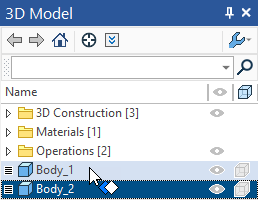
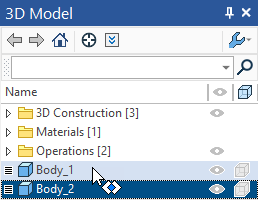
3D Model tree in 3D window
The 3D Model tree can be also displayed in the 3D scene. For this purpose press ![]() icon in the top left corner of the 3D window.
icon in the top left corner of the 3D window.
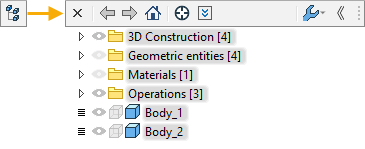
If the 3D Model window becomes at some point not available, when working with a 3D model, then the 3D model tree is automatically expanded in 3D window. This occurs, for example, when entering commands of 3D elements creating or editing. If the expansion of the tree upon commands activation is not required, it is enough to close it once using ![]() and the system will remember this status.
and the system will remember this status.
The 3D model tree in 3D window has a toolbar similar to the toolbar in the 3D Model window. The only difference is the number of columns to be displayed. To hide this toolbar you need to click the special button.
![]()
The tree can be expanded or narrowed. To do this place the cursor on the right edge of the toolbar and move it holding the left mouse button.
![]()
If necessary, you can enable the search panel for the model tree in 3D window:
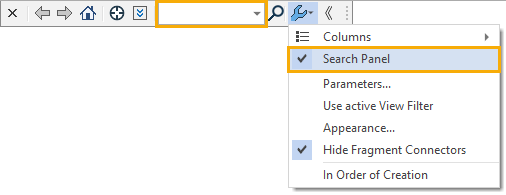
Topics in this section: